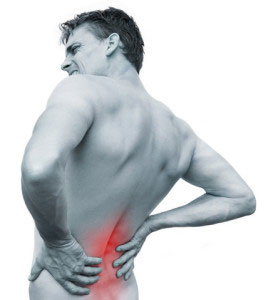
Whether you have a disc abnormality, an irritated nerve root, or arthritis of the spine, Regenerative Medicine may help. Prolotherapy, an affordable Regenerative Medicine option, can help correct the cause one of the most common causes of low back pain which is the stretching of tissues due to injuries or repetitive strain.1,2,3,4

While disc abnormalities and pinched nerves have gotten much of the blame for back pain, ligament injury is a more important source.5
Disc abnormality as the cause of low back pain began with the popularity of MRI scanners in the 1980s because discs are easily seen. Unfortunately, ligament injury often involves micro-tears that do not show up well and are often overlooked.
Many studies have shown that normal people who are free of low back pain despite having abnormal MRI findings.6-12
A study published in the New England Journal of Medicine showed that, out of 98 pain-free people, 64% had abnormal back scans.13
Because MRI’s show abnormalities that may not be causing the problem and may not show abnormalities that are causing the problem, some people are receiving treatments and not getting better, wondering why.
Just because you may have an abnormality on your MRI does not mean that is the cause of the pain. It does not mean that you need to remain on medications or will require surgery.
Many studies have shown that Prolotherapy can be extremely effective for Low Back Pain, even for people who have had pain for 10 years and have tried many different treatments and who have even failed surgery, even 12 years after their treatment was completed as you can see from the following studies.
43 patients with chronic low back pain who had been unresponsive to other treatments, including surgery underwent Prolotherapy to the sacroiliac joint area over a period of six weeks. 93% of the patients reported significant improvement. Only three of the patients reported no improvement.14
656 patients received a total of 18,000 injections 12 years after prolotherapy was completed, 82% of the patients considered themselves cured.15
A double-blind study in one of the most prestigious medical journals was conducted on the most difficult patients with continuous low back pain. These patients suffered for 10 years or longer and had surgery, medications, manipulations, exercise, physical therapy and other treatments. These interventions failed to provide adequate relief for 10 or more years. 88% of the group treated with prolotherapy had moderate to marked improvement.16
91.0% of 177 patients reported a reduction in the level of pain; 85% of patients reported improvement in activities of daily living, and 84% reported an improvement in the ability to work.17
80% of patients with failed back syndrome obtained good to excellent relief of pain following prolotherapy. Patients also reported improvement in work capacity and social functioning.18
1. Borenstein DG. Chronic low back pain. Rheumatological Disease Clinics of North America. 1996. 22: pg. 439-456.
2. Hills EC, Wieting JM, et al. (eds). Mechanical low back pain. Updated 21 November 2004.
3. Borenstein DG. Chronic low back pain. Rheumatological Disease Clinics of North America. 1996. 22: pg. 439-456.
4. Watson JD1, Shay BL. Treatment of chronic low-back pain: a 1-year or greater follow-up. J Altern Complement Med. 2010 Sep;16(9):951-8.
5. Ombregt L, Bisschop P, and Veer HJ. A System of Orthopaedic Medicine, Second Edition. Churchill Livingstone. 2003. p 775.
6. Asymptomatic intervertebral disc protrusion. Acta Radiologica. 1956. 46-49.
7. WE and Whitten RM. Abnormal myelograms in asymptomatic patients. J of Neurosurgery. 1968. 28:204.
8. Wiesel SW et al. A study of computer-assisted tomography: The incidence of positive CAT scans in an asymptomatic group of patients. Spine. 1984. 9:549-551.
9. Powell MC et al. Prevalence of lumbar disc degeneration observed by magnetic resonance in a symptomless woman. Lancet. 1986. 13:1366-1367.
10. Boden SD et al. Abnormal magnetic resonance scans of the lumbar spine in asymptomatic subjects. J of Bone and Joint Surgery. 1990. 72A:503-408.
11. Kaplan PA. MR imaging of the normal shoulder: variants and pitfalls. Radiology. 1992. 184:519-524.
12. Deyo R. Magnetic resonance imaging of the lumbar spine-terrific test or tar baby? NEJM. 1994. 331:115-116.
13. Ibid. ref 12.
14. Schwatrz R. Prolotherapy: A literature review and retrospective study; Journal of Neurology, Orthopedic Medicine and Surgery, 1991: 12:220-223.
15. Hackett M.D. Low back pain British Journal of Physical Medicine 1956 19.25-33.
16. Ongley, M. A new approach to the treatment of low back pain. Lancet July, 1987 2:143-145.
17. Hooper RA; Ding M Retrospective case series on patients with chronic spinal pain treated with dextrose. J Altern Complement Med. 2004 Aug;10(4):670-4.
18. Wilkinson HA1. Injection therapy for enthesopathies causing axial spine pain and the “failed back syndrome”: a single blinded, randomized and cross-over study. Pain Physician, Apr 2005, 8(2) Pg. 167-73.
Disclaimer: All information provided by Dr. Bloom is for educational purposes only It is not intended to prevent, diagnose, treat, or cure any disease or injury. Individual results may vary. No results are guaranteed.
© Copyright 2025. All rights reserved.